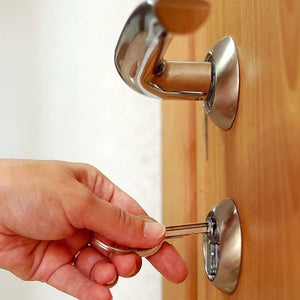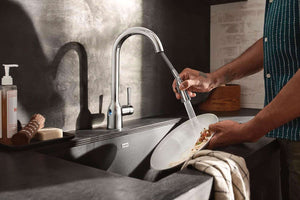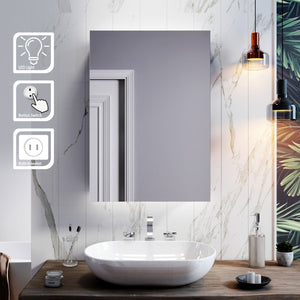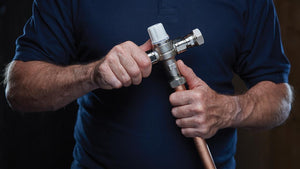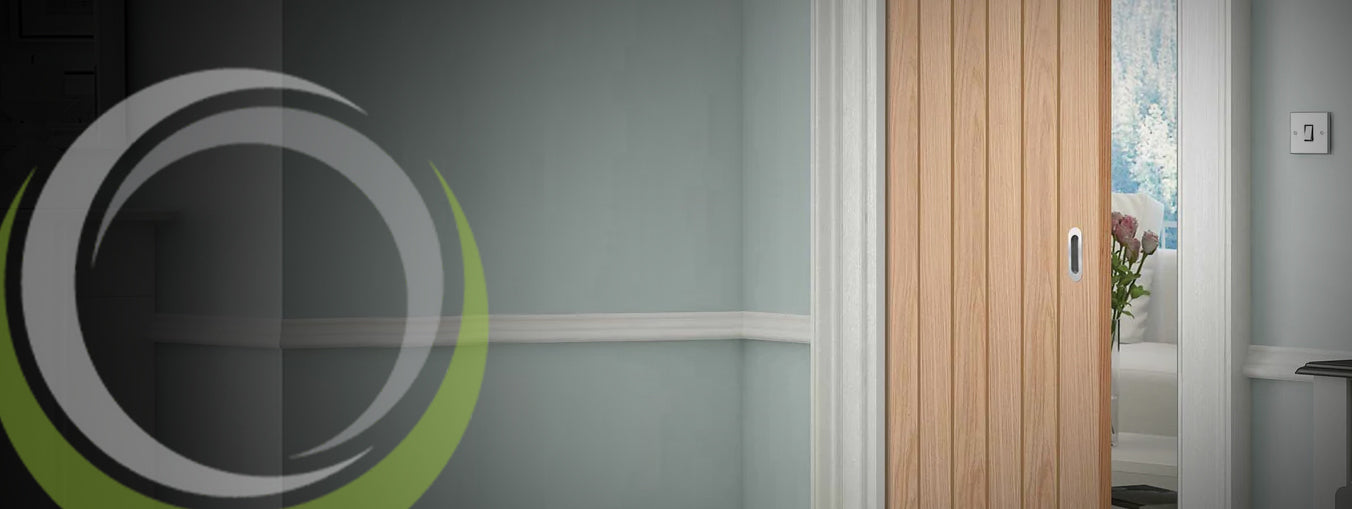
A Comprehensive Guide to Selecting the Right Pocket Door Hardware
Have you ever wished for a door that magically disappears? Look no further than the pocket door lock! These space-saving wonders slide seamlessly into the wall, creating a clean and modern look. But what makes them tick? This guide dives deep into the world of best pocket door hardware, your key to unlocking functionality, security, and style in commercial settings.
Imagine transforming your office, restaurant, or retail space with pocket doors. They're perfect for maximizing tight spaces. Picture a small conference room that feels cramped with a swinging door. With a pocket door lock, the space suddenly feels more open and airy. Pocket doors are also ideal for separating areas without sacrificing valuable square footage. Consider using a pocket door with lock to create a neat divide between a busy kitchen and a peaceful eating room in a restaurant without giving the impression that a wall has been built. Not to be overlooked is the visual attraction. Any commercial area gains a sense of refinement and elegance with the addition of pocket doors. Their modern architecture is wonderfully complemented by their clean and simple style.
But before you get swept away by their magic, let's explore the different types of pocket doors:
- Single Pocket Doors
The classic and most common type! A single door slides neatly into a pocket framed within the wall. This is a versatile option that works well in a variety of commercial settings.
- Bypass Pocket Doors
Double doors glide in opposite directions, ideal for wider openings. Imagine a large conference room that needs to be divided occasionally. Bypass doors allow for maximum flexibility, creating a fully open space when needed.
- Bifold Pocket Doors
Panels fold up and tuck into the pocket, perfect for doorways with limited side space. This is a great option for doorways located in corners or near existing furniture.
Each type has its own hardware requirements. Don't worry, we'll break it down further!
The Hardware Symphony
Just like an orchestra, pocket doors need the perfect hardware to perform flawlessly. Here's the breakdown:
- Tracks and Rollers
These are the stages for your door! Tracks, typically made of steel or aluminum, guide the door's movement. Smooth-rolling rollers ensure a quiet and effortless operation.
- Stops and Soft-Close Mechanisms
Imagine a door slamming shut – not ideal! Door stops prevent damage, while soft-close mechanisms create a gentle, controlled closure for a touch of sophistication.
- Pocket Door Hardware Kits
Convenience at its finest! These kits include everything you need – tracks, rollers, stops, and sometimes even handles – for a seamless installation.
But there's still more! We'll explore the realm of privacy, keyless, and keyed locks, as well as other hardware heroes like floor guides and weatherstripping, as well as pocket door pulls and knobs.
Choosing Wisely
The lifetime and ideal operation of your pocket doors depend on the hardware you choose. We'll walk you through things like door weight, traffic flow, aesthetics, and security requirements. Building codes and accessibility standards (ADA) also play a role in hardware selection. Don't worry, we'll demystify them too!
Get ready to unlock the secrets of pocket door hardware with lock and transform your commercial space! Buckle up, because the next sections will explore each hardware component in detail, helping you choose the perfect pieces for your project.
Types of Pocket Door Hardware

Door Tracks and Rollers
The magic of a pocket door pulls disappearing into the wall isn't just about the door itself. Behind the scenes, a vital hardware component takes center stage: the tracks and rollers. These workhorses ensure smooth, quiet operation and determine the weight capacity of your pocket door latch. Let's delve into the world of tracks and rollers, helping you choose the perfect duo for your commercial space.
Steel vs. Aluminum Tracks
The first decision is the track material: steel or aluminum. Both offer distinct advantages and disadvantages:
Steel Tracks
- Pros: Steel is the champion of strength and durability.It can withstand thick soundproofing material or double bypass doors, among other heavy doors, without buckling or warping. Additionally, steel rails are less prone to being harmed by unintentional bumps or collisions.
- Cons: Steel carries a heavier price tag compared to aluminum. Additionally, steel tracks can be slightly noisier due to their rigidity.
Aluminum Tracks
- Pros: Aluminum is the lightweight champion. It's a more affordable option and easier to work with during installation. Aluminum tracks are also quieter due to their lighter weight.
- Cons: The trade-off for affordability and weight comes in strength. Aluminum tracks have a lower weight capacity than steel and may not be suitable for very heavy doors.
The Right Track Style
Next, we explore different track styles, each suited for specific applications:
Single Track
This is the most basic and common type. A single track guides a single pocket door lock. It's a perfect choice for standard-weight doors in most commercial settings.
Double Track
As the name suggests, double tracks feature two parallel channels. This configuration is ideal for bypass pocket doors where two doors slide in opposite directions.
U-Channel Track
This U-shaped track offers superior stability and is often used for heavier doors. The enclosed design provides additional support and helps prevent the door from swaying.
Exploring Roller Types
Now, let's meet the tiny titans that keep your door gliding effortlessly: the rollers. There are three main types:
Single Wheel Rollers
These basic rollers have a single wheel attached to a mounting bracket. They are suitable for lighter doors in low-traffic areas.
Double Wheel Rollers
Double the wheels, double the stability! These rollers have two wheels per bracket, offering better weight distribution and smoother operation for heavier doors. This is the recommended choice for most commercial applications.
Ball Bearing Rollers
Ball bearing rollers are the only option if you want the smoothest glide imaginable. These rollers operate with extremely little friction and with great quietness since ball bearings are placed within the wheels. Large doors and busy areas are the perfect fit for them.
Putting Tracks and Rollers Together
Installing tracks and rollers requires careful attention to detail. Here are some key considerations:
Track Alignment
Ensuring perfect alignment of the tracks is crucial for smooth door movement. Even a slight misalignment can cause the door to bind or scrape.
Leveling
Tracks need to be perfectly level for proper door operation. Using a level during installation is essential.
Stud Placement
Tracks need to be securely fastened to wall studs for optimal support. Locating studs before installation is crucial.
Roller Selection
Matching the roller type to the door weight and desired performance is vital. Heavier doors require more robust rollers for longevity.
By understanding the different types of tracks, rollers, and installation considerations, you're well on your way to selecting the perfect duo for your pocket door hardware symphony. The next sections will explore other crucial hardware components like handles, locks, and more, ensuring your pocket door functions flawlessly and complements your commercial space.
Getting the Right Tracks and Rollers
- Heavy doors, heavy duty
Your bulky file cabinets need steel tracks. They can handle the weight and won't bend easily. Aluminum is lighter on your wallet, but only for regular doors.
- Buy in bulk, save time
Negotiate discounts for common track lengths and roller types. This way, you'll have what you need for future projects without waiting on special orders.
- Standardize for smooth sailing
Pick a few high-quality track-and-roller combos. This makes ordering easier and your crews won't waste time figuring things out on-site. Measure doorways beforehand to get the perfect track length and roller strength for each door.
Door Stops and Soft-Close Mechanisms

Pocket doors give your house a sleek, contemporary appearance while being a great space-saving option. But, to operate flawlessly and last a lifetime, pocket doors need the right hardware, just like any other door. Door stops and soft-close mechanisms are two essential parts of pocket door hardware. These ostensibly straightforward components are essential for safeguarding your door against harm and improving user experience in general.
Finding the Perfect Fit
There are two main types of door stops commonly used for pocket doors:
Floor-Mounted Door Stops
The ends of the pocket door latch kit have these tiny, inconspicuous stops that are fastened straight into the ground. Usually constructed of rubber or metal, they are available in a range of sizes and shapes. Floor-mounted stops are a common option because of their discreet form and simplicity of installation. But in order to prevent creating a trip hazard, it's crucial to select a low-profile stop.
Wall-Mounted Door Stops
Wall-mounted door stops are bolted to the wall where the pocket door pull handle ends. These stops are more visually pleasant than floor-mounted ones since they come in a range of shapes and finishes to fit your current decor. When there is a need for aesthetics or when floor space is limited, they are ideal. However, it might not always be practical to drill into the wall in order to install some wall-mounted stops.
Soft-Close Mechanisms
Soft-close mechanisms go beyond door stops in preventing your pocket door from slamming shut entirely. These mechanisms, which use either hydraulic or pneumatic technology, are built into the pocket door latch.
Hydraulic Soft-Close
This device uses a piston filled with hydraulic fluid. When the door approaches the end of its track, the piston engages, slowing its movement and allowing it to close gently and quietly.
Pneumatic Soft-Close
A hydraulic fluid-filled piston is used in this arrangement. The door slows down to give a silent and seamless closing as it approaches the end of its track thanks to the piston's engagement.
Getting the Right Door Stops and Soft-Close Mechanisms
- Stops that blend in or stand out
Floor stops are discreet, while wall stops offer more design options. Soft-close mechanisms (hydraulic or pneumatic) are magic for high-traffic areas – no more door slams!
- Bulk buys for busy guys
Get floor stops and soft-close mechanisms in bulk, focusing on the most popular types. Match the finishes to your office style for a cohesive look.
- Plan it out
Decide on floor or wall stops during the planning phase, considering aesthetics and space limitations. Choose your soft-close mechanism (noisy areas benefit from noise reduction) and integrate them seamlessly during track installation.
Pocket Door Hardware Kits
Pocket doors improve space and attractiveness, but they must be installed with specialized hardware. Pre-assembled hardware kits provide advantages over purchasing individual components. This tutorial discusses the benefits of utilizing hardware kits, the common components they include, and how to select the best kit for your pocket door pull project.
Typical Components Included in Pocket Door Hardware Kits
Here's a breakdown of the essential components commonly found in pocket door hardware kits:
- Tracks
These are the metal channels that guide the handles for pocket doors as it slides open and closed. Kits typically offer tracks in various lengths to accommodate different door sizes.
- Rollers
These are heavy-duty wheels attached to the bottom of the pocket door pull that allow it to glide smoothly within the track. Kits might offer different roller types depending on the weight capacity.
- Door Stops
These prevent the door from slamming into the wall at the end of its track. Kits might include different types of stops (floor-mounted or wall-mounted) to suit your preference.
- Floor Guides
These small fixtures attached to the bottom of the door help ensure proper alignment and prevent the door from swaying as it slides.
- Handles or Pulls
These provide a way to open and close the pocket door. Kits might offer a variety of handle styles and finishes to complement your decor.
- Additional Hardware
Some kits might include extras like soft-close mechanisms for a gentle door closure, pocket door latches for basic privacy locking, or privacy pocket door hardware for a more secure lock.
Getting the Right Pocket Door Hardware Kits
Selecting the ideal and modern pocket door hardware kit requires considering several factors:
- Door Weight
Kits are designed to handle specific weight capacities. Ensure the chosen kit can accommodate the weight of your pocket door latch kit to ensure smooth operation and prevent premature wear and tear.
- Door Size
Track lengths within kits typically cater to a range of door sizes. Choose a kit that offers a track long enough for your entire door to disappear completely within the wall cavity.
- Desired Functionality
Consider if you want basic functionality (door opening and closing) or additional features like soft-close mechanisms or locking options. Look for kits that include pocket door handle lock or privacy pocket door hardware if needed.
- Material and Finish
Kits come in various materials (steel, aluminum) and finishes (chrome, nickel). Select a material and finish that aligns with your door material and complements your overall decor. Explore options like modern pocket door handles for a contemporary look.
- Brand Reputation
Opt for kits from reputable brands known for their quality and customer service.
Pocket Door Handles and Locks
Pocket doors offer a clever way to save space and enhance the aesthetics of your home. But just like other doors, they rely on appropriate hardware for pocket doors optimal functionality and appearance. This guide explores the world of pocket door handles with lock and locks, guiding you towards practical and stylish choices that complement your space and door design.
Handles
Different types of pocket door handles offer unique looks and sensations. Here's an overview of the most common styles:
- Pulls
Pocket door handles, also known as door pulls, are affixed directly to the door's surface. They focus comfort and use, allowing for simple one-handed control. Their versatility makes them excellent for high-traffic environments. Door pulls come in a number of styles, from contemporary to rustic, to suit any design sensibility.
- Knobs
These spherical or rounded handles offer a classic and elegant look. While aesthetically pleasing, knobs might require two hands to operate, which might not be ideal for all situations.
- Flush Pulls
These handles are recessed into the pocket door knob surface, creating a minimalist and seamless appearance. They are ideal for modern interiors and provide a clean, uncluttered look.
Locks
While some pocket doors might not require locks, having the option to secure a space can be crucial for privacy and security. Here's a breakdown of different pocket door lock mechanisms:
- Keyless Locks
These locks operate with a code or fingerprint scan, offering a convenient and touchless approach. They are ideal for situations where physical keys might be easily misplaced.
- Keyed Locks
The traditional and reliable option, keyed locks require a physical key to operate. They are a good choice for areas where a higher level of security is desired.
- Privacy Locks
These locks typically feature a thumb turn mechanism on the inside of the door and can be locked from within for privacy. They are ideal for bathrooms and bedrooms.
Getting the Right Pocket Door Handles and Locks
- Security matters
Keyless locks are handy, keyed locks offer more security, and pocket door privacy locks are perfect for restrooms.
- Bulk up on popular choices
Buy handles and locks in bulk for popular styles and finishes (pulls, knobs, keyed/privacy locks) to cater to different office areas.
- Plan for function
Match handle and lock type (keyed/keyless) to the specific needs of each space during the planning phase. This ensures you order the right hardware and avoids installation delays.
Additional Hardware Considerations
While door stops and soft-close mechanisms are essential for smooth operation, there are other hardware components that can enhance the functionality and performance of your pocket door.
- Weather Stripping
This thin, flexible material is installed along the edges of your pocket door handles with lock. It creates a tighter seal between the door and the pocket, improving soundproofing and privacy. Weather stripping is particularly beneficial for pocket doors separating noisy areas like laundry rooms or media rooms from quieter spaces.
- Floor Guides
These are small brackets mounted on the floor at the bottom of the pocket door latch. They provide additional stability, especially for heavy pocket doors. Floor guides prevent the door from swaying or wobbling as it slides open and closed, ensuring smooth and effortless operation.
- Electronic Access Control Systems
For advanced security needs, electronic access control systems can be integrated with pocket door locks. These systems allow access to be granted or denied using key cards, fobs, or even smartphone apps. This can be a valuable addition for commercial settings, offices, or areas requiring restricted access.
Conclusion
Don't let pocket doors become a commercial headache! This guide equips you to navigate the world of hardware and make informed decisions for seamless operation and a touch of elegance in your space. Forget clunky slamming doors and wasted square footage – with the right hardware, your pocket doors become functional works of art.
Don't Be a Door Dummy, Get Your Pocket Hardware Chummy.
From understanding the role of each component to navigating key choices like tracks, rollers, and locks, you'll be a pocket door hardware pro in no time. Steel tracks offer the strength for bulky file cabinets, while aluminum keeps things light on your wallet for regular doors. Rollers come in single, double, and ball-bearing varieties, ensuring smooth gliding for any weight. Stops prevent damage, while soft-close mechanisms create a gentle, sophisticated closure. Pre-assembled kits offer convenience, but consider factors like door weight, size, and desired features (soft-close, locks) for optimal functionality.
Informed decisions are key. Hardware finishes should complement your space's decor, while locks provide the necessary security level for different areas. Building codes and ADA standards might also play a role.
For complex projects or to guarantee optimal hardware selection, don't hesitate to consult with hardware suppliers or qualified professionals. Their expertise can be the key to unlocking the full potential of your pocket door handles project. So, unleash the space-saving power and sleek design of pocket doors – with the right hardware, your commercial space is ready to transform, not just impress!
Buy Pocket Door Locks NOW

